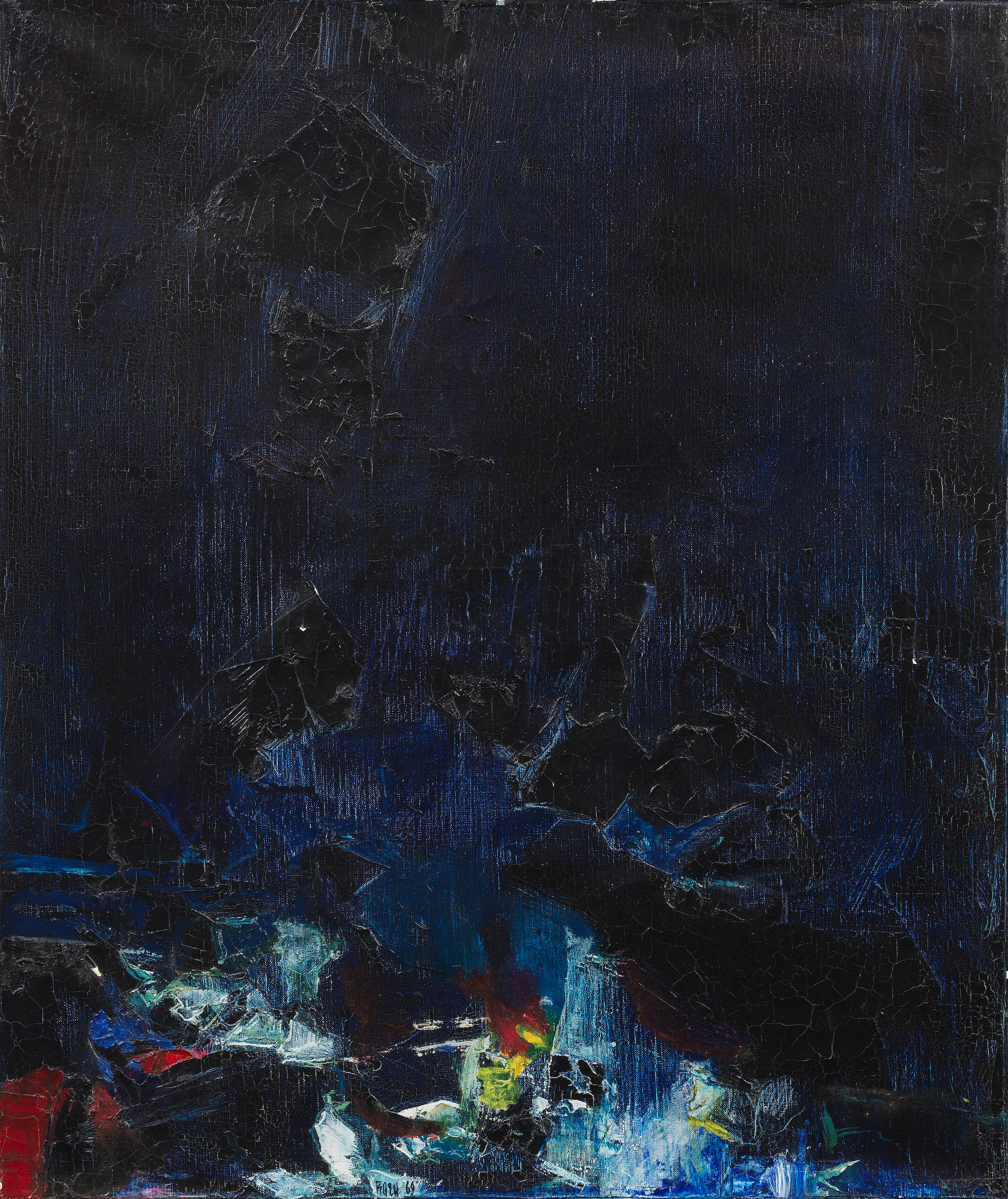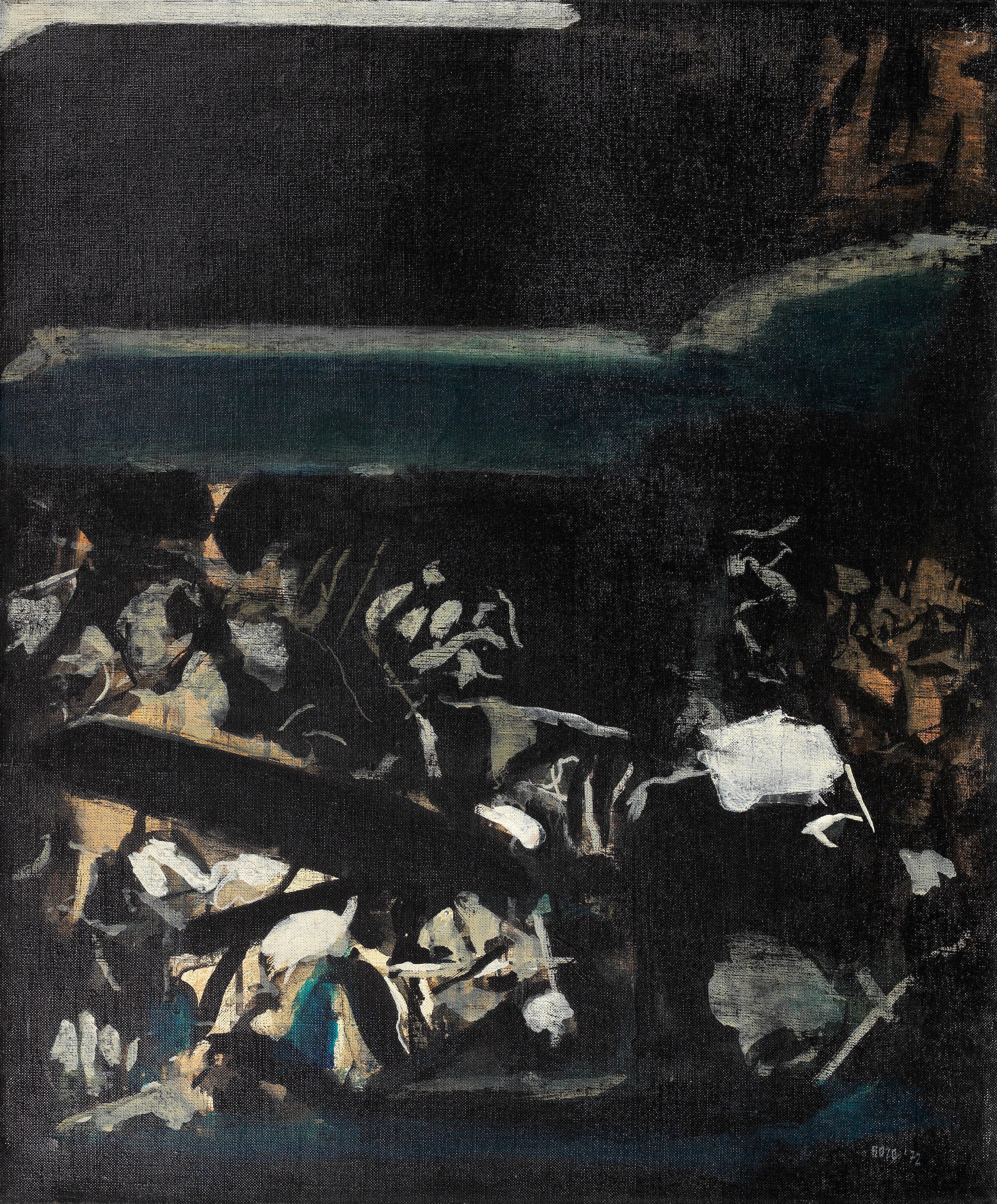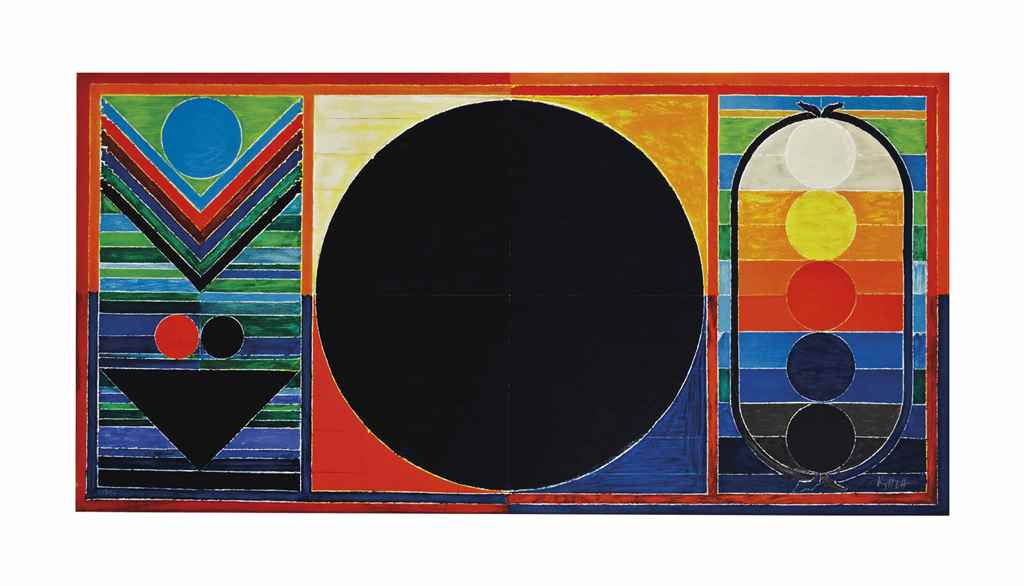Sayed Haider RAZA (1922-2016). Paysage Agreste, 1961. Importante huile sur toile, signée en bas vers la droite et datée (19)61. Le dos de la toile contresigné, marqué « P_327'61 » et « 206 x 120 cm ». H_120 cm L_200 cm Dans un cadre baguette noir. Provenance : Galerie Lara Vincy, Paris, acquis vers 1965-1966. Collection de M. et Mme C. Cette œuvre sera incluse dans l'édition révisée SH RAZA, Catalogue Raisonné, Volume I, (1958-1971) par Anne Macklin au nom de The Raza Foundation, New Delhi (Image ref SR2761). Notre toile est référencée par un tirage photographique ancien dans les archives de la Galerie Lara Vincy ATTENTION : Pour pouvoir enchérir en live sur ce lot, merci de bien vouloir vous rapprocher de la maison de ventes par e-mail à antibes@metayer-auction.com WARNING : To be able to bid live on this lot, please contact the auction house by mail before to register, at antibes@metayer-auction.com Nous remercions The Raza Foundation, New Delhi, qui dans un courrier du 4 mai 2023 confirme l'inclusion de cette toile au Catalogue Raisonné de l'artiste. Nous remercions personnellement Madame Anne Macklin, chercheuse et rédactrice du catalogue raisonné de l'œuvre de Sayed Haider Raza, pour son assistance à la rédaction de la fiche de notre tableau. Born in Babaria, Madhya Pradesh in 1922, Raza moved to the bustling streets of Bombay in 1943 to study at the Sir J.J. Schoolof Art. In Bombay, he became one of the founding members of the revolutionary Bombay Progressive Artists' Group formed in the year of India's Independence in 1947. His works of this period are fluid watercolours of landscapes and townscapes his most notable works being those that depict the rains of the monsoon flooding the streets of his new city. With little money and few acquittances, these early years were challenging for Raza. However, Raza's move to France in 1950 to study at the École des Beaux-Arts, Paris saw a change in both his style and fortunes. In France, Raza immersed himself in the culture, visiting the country's many museums and art galleries and travelling extensively throughout Europe. Initially, his works were influenced by medieval and Renaissance art, Cézanne's cubist style and the intricate Indian miniatures of home. Raza's paintings were carefully constructed townscapes in gouache, as Jacques Lassaigne noted 'strange and unusual works: timeless landscapes, uninhabited cities detached from earth, bathed in cold light'. Raza finished his studies in 1953 and this year coincided with his move away from gouache to oils, a move which proved to be decisive in his artistic evolution. The restrained manner of his 'classic' period was replaced with a more fluid technique resemblant of the work of the Post-Impressionists. Raza continued to paint organized landscapes that show visible elements such as church spires, houses and trees, but they are now a spectacle of colour and shape. As Rudolf von Leyden comments, "the gouache technique in tempera was to give way to impasto in oil. The change of medium and manner was not merely technical but signified a fundamental change of attitude. The scholar, who had measured and calculated, burst through the confines of a limited understanding of colour and space created by colour into a sphere of full realization. The transformation created such passion that one could best describe this age of Raza as the age of the Lover. This triumphant handling of paint, this living paint can only be understood as an act of love. His colours take on an entirely new complexion. Brilliant reds and yellows stand out against large looming forces of black and deep Prussian blue. Shapes dissolve in seas of colours which are by no means unorganized and fluid but seem to move and evolve within the space of the painting." Over the coming years, Raza's works became less and less tied to a specific place and instead sought to evoke a temperature, a season, a climate, a time or a feeling. His brushstrokes became more spontaneous, his fo
Sayed Haider RAZA (1922-2016). Paysage Agreste, 1961. Importante huile sur toile, signée en bas vers la droite et datée (19)61. Le dos de la toile contresigné, marqué « P_327'61 » et « 206 x 120 cm ». H_120 cm L_200 cm Dans un cadre baguette noir. Provenance : Galerie Lara Vincy, Paris, acquis vers 1965-1966. Collection de M. et Mme C. Cette œuvre sera incluse dans l'édition révisée SH RAZA, Catalogue Raisonné, Volume I, (1958-1971) par Anne Macklin au nom de The Raza Foundation, New Delhi (Image ref SR2761). Notre toile est référencée par un tirage photographique ancien dans les archives de la Galerie Lara Vincy ATTENTION : Pour pouvoir enchérir en live sur ce lot, merci de bien vouloir vous rapprocher de la maison de ventes par e-mail à antibes@metayer-auction.com WARNING : To be able to bid live on this lot, please contact the auction house by mail before to register, at antibes@metayer-auction.com Nous remercions The Raza Foundation, New Delhi, qui dans un courrier du 4 mai 2023 confirme l'inclusion de cette toile au Catalogue Raisonné de l'artiste. Nous remercions personnellement Madame Anne Macklin, chercheuse et rédactrice du catalogue raisonné de l'œuvre de Sayed Haider Raza, pour son assistance à la rédaction de la fiche de notre tableau. Born in Babaria, Madhya Pradesh in 1922, Raza moved to the bustling streets of Bombay in 1943 to study at the Sir J.J. Schoolof Art. In Bombay, he became one of the founding members of the revolutionary Bombay Progressive Artists' Group formed in the year of India's Independence in 1947. His works of this period are fluid watercolours of landscapes and townscapes his most notable works being those that depict the rains of the monsoon flooding the streets of his new city. With little money and few acquittances, these early years were challenging for Raza. However, Raza's move to France in 1950 to study at the École des Beaux-Arts, Paris saw a change in both his style and fortunes. In France, Raza immersed himself in the culture, visiting the country's many museums and art galleries and travelling extensively throughout Europe. Initially, his works were influenced by medieval and Renaissance art, Cézanne's cubist style and the intricate Indian miniatures of home. Raza's paintings were carefully constructed townscapes in gouache, as Jacques Lassaigne noted 'strange and unusual works: timeless landscapes, uninhabited cities detached from earth, bathed in cold light'. Raza finished his studies in 1953 and this year coincided with his move away from gouache to oils, a move which proved to be decisive in his artistic evolution. The restrained manner of his 'classic' period was replaced with a more fluid technique resemblant of the work of the Post-Impressionists. Raza continued to paint organized landscapes that show visible elements such as church spires, houses and trees, but they are now a spectacle of colour and shape. As Rudolf von Leyden comments, "the gouache technique in tempera was to give way to impasto in oil. The change of medium and manner was not merely technical but signified a fundamental change of attitude. The scholar, who had measured and calculated, burst through the confines of a limited understanding of colour and space created by colour into a sphere of full realization. The transformation created such passion that one could best describe this age of Raza as the age of the Lover. This triumphant handling of paint, this living paint can only be understood as an act of love. His colours take on an entirely new complexion. Brilliant reds and yellows stand out against large looming forces of black and deep Prussian blue. Shapes dissolve in seas of colours which are by no means unorganized and fluid but seem to move and evolve within the space of the painting." Over the coming years, Raza's works became less and less tied to a specific place and instead sought to evoke a temperature, a season, a climate, a time or a feeling. His brushstrokes became more spontaneous, his fo


.jpg)
.jpg)
.jpg)






.jpg)



Testen Sie LotSearch und seine Premium-Features 7 Tage - ohne Kosten!
Lassen Sie sich automatisch über neue Objekte in kommenden Auktionen benachrichtigen.
Suchauftrag anlegen